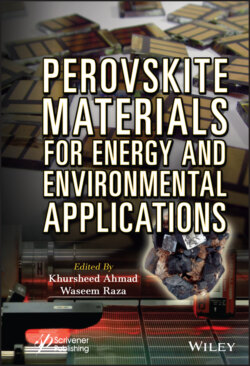Читать книгу Perovskite Materials for Energy and Environmental Applications - Группа авторов - Страница 37
2.2 Structure
ОглавлениеPerovskite is the material having the same compound formula as CaTiO3. Perovskite materials have the general formula of ABX3. Gustav Rose discovered this compound from the Ural Mountains of Russia in 1839 and was named after the mineralogist Lev Perovskite (1792-1856). The Perovskite structure was first described by Victor Goldschmidt in 1926. Perovskite can be divided into two types—inorganic oxide perovskite and halide perovskite. Halide perovskite are further divided into alkali halide perovskite and organo-metal halide perovskite where in A, B, and X vary as mentioned in Table 2.1 [6].
Table 2.1 Types of perovskite structures.
| Types of perovskite structure | A | B | X |
| Inorganic oxide perovskite | Divalent ions—Pb2+, Sn2+, Ca2+, Mg2+, etc | Tetravalent metal ions— Ti4+, Sn4+, etc | O |
| Alkali halide perovskite | Monovalent ions— Na+, Li+, etc | Divalent ions— Pb2+, Sn2+, Ca2+, Mg2+, etc | Halogen—Cl−, Br−, I− |
| Organo-metal halide perovskite | Organic cations— methylammonium (CH3NH3) and formamidinium (HC(NH2)2) | Divalent ions—Pb2+, Sn2+, Ca2+, Mg2+, etc | Halogen—Cl−, Br−, I− |
Perovskite has a cubic structure as shown in Figure 2.3. A is situated on the vertex, B is at the center, whereas X is situated at the face center. It is equivalent to an octahedral structure.
A small defect in the lattice decreases the symmetry of a crystal [7]. The perovskite mineral is itself distorted, and because of this distortion, many physical properties, like electronic, magnetic, and dielectric behavior, are impacted. The ideal cubic perovskite structure is not common. It has been reported that if the grain surface of perovskite (CH3NH3PbI3) is chemically modified by spin-coating of 4-ABPACl, butylphosphonic acid 4-ammonium chloride then the efficiency and stability both improve. 4-ABPACl forms crosslink with perovskite by the formation of hydrogen bond between perovskite (CH3NH3PbI3) iodine and –PO(OH)2, –NH3+, as a result, the cohesion force increases between neighboring perovskite grains [8].
Figure 2.3 The crystal structure of the perovskite [6].
